
India’s ATGMs : Lethal Anti Armour Capability
Mon, 02 Aug 2021 | Reading Time: 8 minutes

An ATGM or Anti- Tank Guided Weapon (ATGW) is a guided missile designed to defeat armoured combat vehicles. Development has focused on two primary objectives- sufficient lethality to defeat armour in vogue and adequately portable for use by the Infantry. The development of composite armour saw induction of ATGMs with tandem-warheads, which in turn catalyzed the development of Explosive Reactive Armour (ERA). Modern top-attack ATGMs are now designed to defeat this feature.
ATGMs range in size from shoulder-fired weapons transported by a single soldier, to larger tripod-mounted weapons, which require multiple persons to transport/ fire and on to vehicle and aircraft mounted systems. The broad categorization of ATGM ‘Generations’ are given in succeeding paragraphs.
First Generation ATGMs. First Generation ATGMs (1950s-1960s) were Manually Command Guided onto Line of Sight (MACLOS) missiles, which required to be continuously guided by a stationary operator onto the target using cross- hairs, thus inevitably exposing the operator to enemy action. The first such missile to see combat was the French Nord SS 10 in the early 1950s, which was used by the French, US and Israeli Defence Forces.
Second Generation ATGMs. Second Generation ATGMs (1970s-1980s) were Semi- Automatic Command Guided to Line of Sight (SACLOS) missiles which required a stationary operator to only keep the sights on the target till impact. Guidance commands were automatically sent to the missile via a wire or radio link, or executed by LASER / TV homing in the nose cone of the missile. The Russian Konkurs/9M133 Kornet & French MILAN-2T, all employed by the Indian Army (IA); Pakistan’s Baktar- Shikan, based on Chinese HongJian (HJ- 8) (Red Arrow 8) & US BGM-71 TOW (in use with Pakistan) and US Hellfire are some examples.
Third Generation ATGMs. Third Generation (TG) ATGMs (1990s) are the ‘fire and forget’ class of ATGMs which utilise a nose mounted LASER, Electro-Optical (EO), Infra-Red (IR) or Radar Seeker to guide themselves onto the target. While these missiles lend to autonomy and operator safety, these are naturally more susceptible to Electronic Countermeasures (ECM) than the earlier generations of missiles, which used closed loop guidance. The Chinese HJ-10 Red Arrow, Israeli Spike, India’s NAG & MPATGM and the US Javelin are some examples.
Fourth Generation ATGMs. Fourth Generation ATGMs (present day) are ‘fire and forget’ ATGMs which have greater effective range and use a combination of seekers for guidance. Examples are India’s Stand- Off Anti- Tank Missile (SANT), with a range of up to 20 km and Israel’s Spike Long range (LR) ATGM.
Indigenous ATGM Journey
Post-Independence, the Indian Government constituted a Special Weapons Development Team (SWDT) in 1958 to study and develop guided missile systems. Phase-I under the aegis of the SWDT commenced in 1959 to develop a First-Generation wire-guided ATGM with a HEAT warhead. The project was eventually terminated in 1969 when the IA upgraded its operational range requirements to 2 km. Even though the project met with limited success, the work in this field saw the establishment of manufacturing facilities of guidance & propulsion systems, material manufacture and airframes that was to stand the ATGM missile industry in good stead later.
The 1980s saw the initiation of India’s Integrated Guided Missile Development Program (IGMDP) led by DRDO, which resulted in a number of technology demonstration programs that would become the bedrock for development of indigenous rocket and missile systems. It was under the IGMDP that the project for the Third Generation NAG ATGM was conceived.
NAG ATGM. The NAG (Cobra) ATGM is an umbrella TG ATGM project, developed at a cost of Rs. 300 Crores, under which a number of variants have been produced, as elucidated below. The ATGM is an all-weather, ‘fire-and-forget’, missile which uses tandem, high explosive warheads with improved kill probability. NAG is manufactured by Bharat Dynamics Limited (BDL). Alongside, the NAG Missile Carrier (NAMICA), an indigenously built BMP-2 with additional wheels, nicknamed ‘Sarath’, successfully completed amphibious trials in August 2008. Sarath is equipped with a thermal imaging sight and a laser-range finder for target acquisition and carries a total of 12 ATGMs, with eight in ready-to-fire mode. The IA placed an order for 443 NAG ATGMs and 12 NAMICA Carriers in 2008. A change in qualitative requirements by the IA, however, led to delays in supply of the order. Further upgradation of the sighting system and Imaging Infra-Red (IIR) Seeker as well as work for improvement in the hit capability of the ATGM led to the induction being put on hold. The final trials with a live warhead were successfully completed on 21 Oct 2020 and the ATGM was declared ready for induction into the IA.
- Prospina. The Prospina is the base-variant land-attack version of the NAG ATGM. It is man-portable and can be mounted on the Sarath. The ATGM is equipped with a solid-propellant rocket booster and a separate sustainer motor and has a range of 500m to 4 km. Mid-course guidance is provided with a two-way data link. Terminal homing is provided by IIR and millimetric wave active radar homing (MMW). The ATGM is tipped with an 8 kg tandem-charge HEAT warhead, which is top-attack capable and provides penetration >900m against ERA/ Rolled Homogenous Armour (RHA). The airframe is made of composite material with four foldable wings and four tail fins for in-flight stabilisation. Single shot kill probability (SSKP) of the missile is claimed to exceed 90%.
- HELINA/ Dhruvastra. The Helicopter Launched NAG (HELINA) (IA) or Dhruvastra (IAF), is the air-launched extended range (ER) variant of the NAG ATGM. It can be launched from the Advanced Light Helicopter (ALH) Rudra/ Light Combat Helicopter (LCH), which have been described in detail @ Chanakya Forum https://chanakyaforum.com/an-indian-helicopter-story/ .The ATGM is guided by an IIR seeker operating in lock-on-before-launch (LBL) mode, a pre-requisite for air-to-ground engagements. The missile has an operational range of 7-10 km and a speed of 230 m/s, with both top-attack and direct hit capability. The HELINA/Dhruvastra underwent a series of multi-mission user trials and were declared ready for induction into the IA and IAF respectively in February 2021.
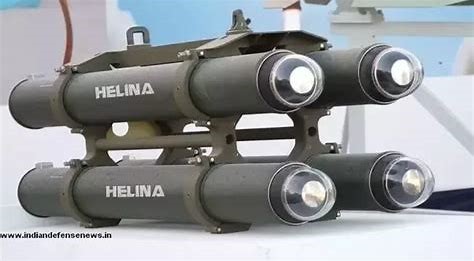
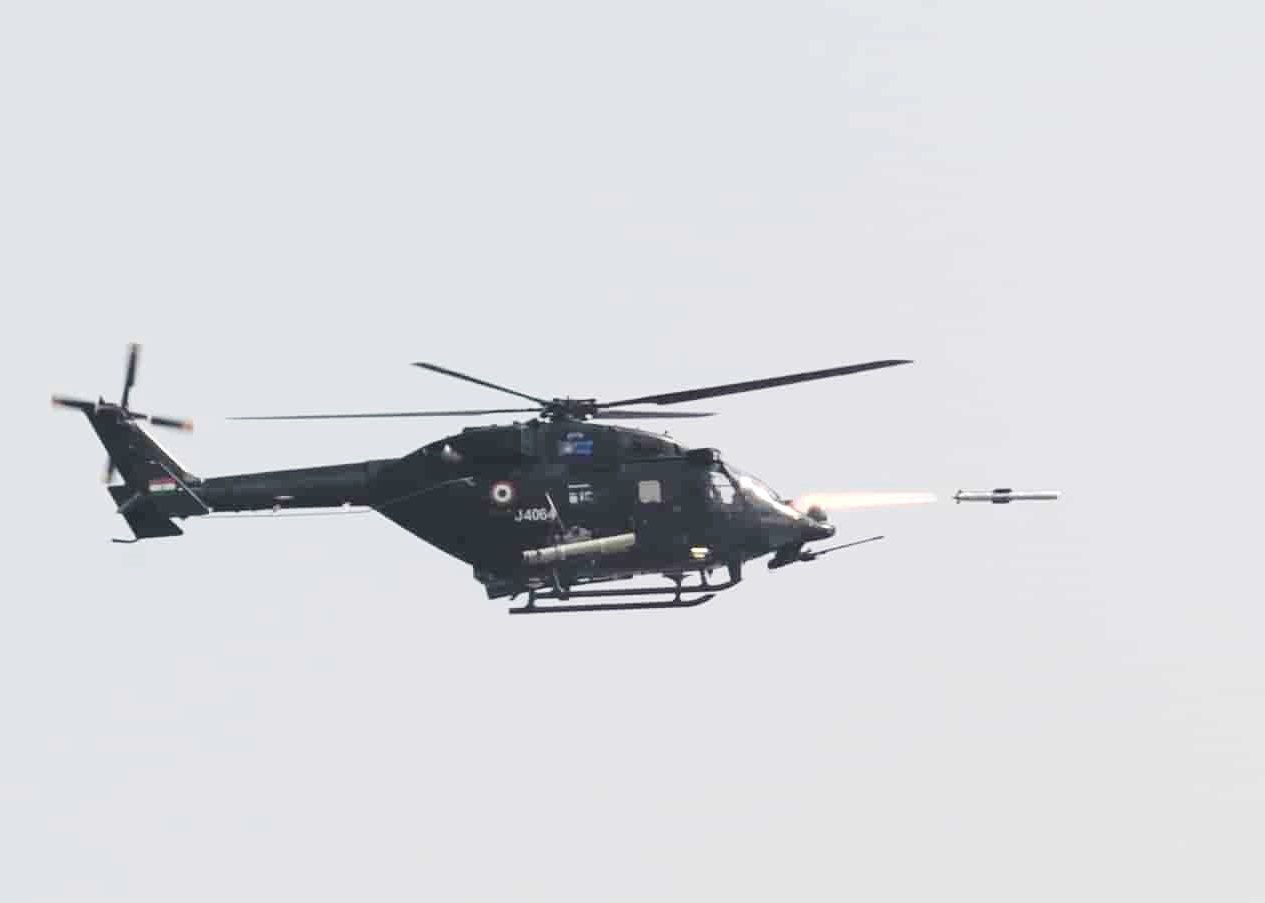
HELINA ATGM, Being Fired from ALH RUDRA: Source-indiandefencenews.in, IA
- MPATGM. The Man Portable ATGM (MPATGM) is a TG ATGM derived from the NAG ATGM and is served by a two person crew. The missile has been developed by the DRDO in partnership with Indian firm VEM Technologies Private Ltd and is being manufactured by BDL. Development was sanctioned by MoD in January 2015. The missile uses IIR guidance and has an effective range of 2.5 Km. A light weight miniaturised IIR seeker that uses Artificial Intelligence for mid-flight correction onto the vulnerable portion of the target has also been developed by BDL with private partnership. The ATGM carries two HEAT tandem warheads and is capable of top-attack. It is powered by a dual thrust solid fuel rocket with blast tube ejection motor-the former serves to initially ‘boost’ the ATGM rapidly to high speed and subsequently to ‘sustain’ it in flight at a slow rate of burn, thus improving accuracy. The ejection motor aids in ‘soft launch’ or non-explosive ejection, allowing the rocket motor to be ignited outside the (collapsible) tripod- mounted launch tube, thus providing safety to the operator and the launcher- an essential feature of a MPATGM. The missile weighs 14.5 Kg while the Command Launch Tube (CLU) weighs 14.25 Kg. User trials were planned for completion in 2020 but were postponed due to the COVID pandemic. The ATGM is slated to replace the MILAN-II and Konkurs ATGMs with the Infantry, Airborne Battalions and Special Forces. On 21 July 2021, the MPATGM successfully underwent its fourth flight test to validate minimum range and in-flight stability, wherein the miniaturised IIR seeker was also successfully validated.
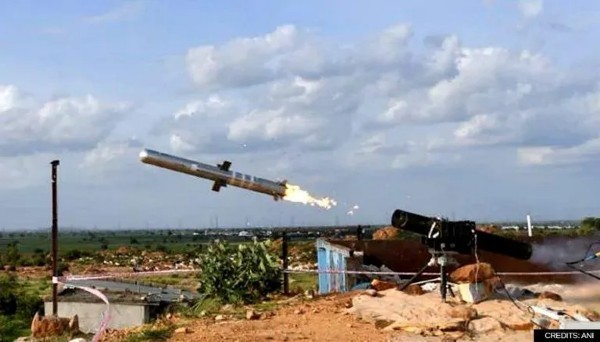
Test Firing of MPATGM: Source-ANI
- SANT. The Standoff ATGM (SANT) is a Fourth-Generation upgraded variant of HELINA, developed for long range anti-armour engagement. It uses dual nose-mounted of EO/ IR and MMW seekers. It has a range up to 20 km with LBL and lock-on-after-launch (LAL) capabilities. It is also reportedly intended to mount the SANT on fighter jets of the IAF and the indigenous Rustom/Ghatak stealth UCAVs, described @ Chanakya Forum https://chanakyaforum.com/indias-tryst-with-uav-from-surveillance-to-strike/. The missile, with its 20 km range, would be superior to the Israeli Spike LR (16 Km) or US Hellfire (11 Km) ATGMs in terms of effective range. DRDO successfully test fired the missile on 19 October 2020.
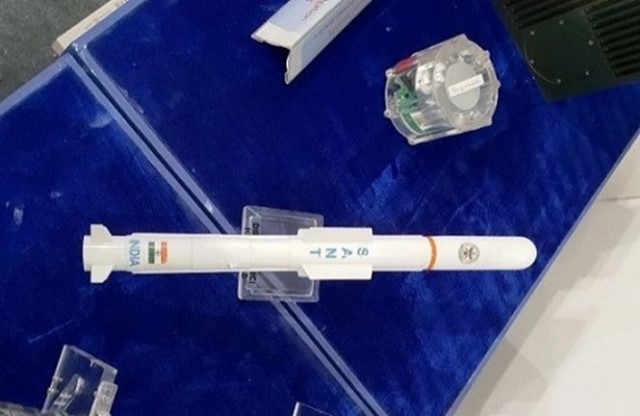
SANT ATGM: Source-DRDO
SAMHO ATGM. The Semi-Active Mission Homing Missile (SAMHO) is a TG cannon-launched ATGM under development by DRDO’s Armament Research and Development Establishment (ARDE) under the Cannon Launched Missile Development Program (CLMDP). The missile uses semi-active LASER homing and is fired from the 120mm rifled main gun of the Arjun Main Battle Tank (MBT). Plans also exist to make it compatible for firing from the 125 mm smooth bore main gun of the T-90 MBT. The ATGM has an operational range of 1.5 to 5 Km. It carries two HEAT tandem warheads designed to defeat ERA of modern MBTs and is also for use against low-flying helicopters. Trial firing was successfully carried out in September-October 2020. The missile is similar to the Israeli LAHAT and the Russian 9M119 Svir cannon launched ATGMs.

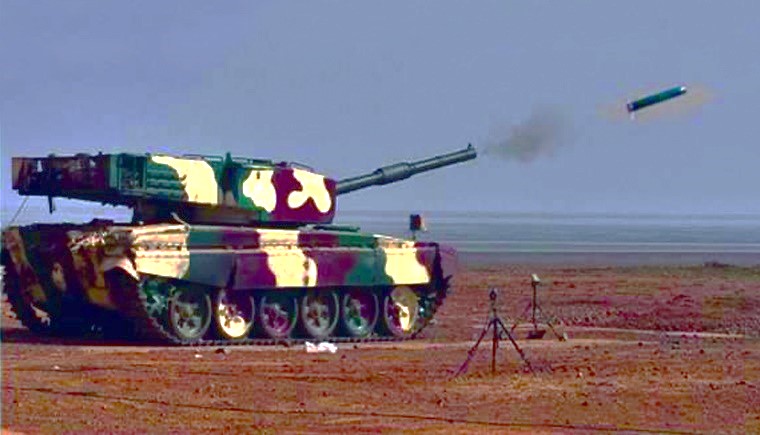
SAMHO ATGM, Being Fired from MBT Arjun: Source-drdo.gov.in, pib.gov.in
Amogha ATGM. The Amogha (Fearlessness, Unerring) ATGM is developed by BDL with DRDO consultation. Amogha-I & II are equipped with SACLOS guidance while Amogha-III, a TG IIR guided ATGM with LBL capability is being developed. The ATGM will be produced in the land/air launched versions- the latter likely to be mounted on the ALH Rudra/ LCH. It is man portable with tandem warheads and top/direct attack capability, reportedly capable of defeating > 650 mm ERA. The ATGM is propelled by a solid-fuel rocket motor with thrust vector control, facilitating mid-flight corrections. Amogha-III, with a reported operational range of 2.5-2.8 Km, was displayed by BDL during Def Expo-2020. The ATGM is in developmental (testing) phase.

Amogha III ATGM: Source-defenceforumindia.com
Fifth-Generation ATGM. India’s Larsen &Toubro has entered into a Joint Venture with MBDA, a European missile manufacturer, to produce an indigenous Fifth- Generation ATGM (ATGM5) with a range of 4 Km. The ATGM5 is likely to feature state-of-art disruptive technologies including latest passive dual band seeker, i.e. TV and uncooled IIR with 3D target designation and is reportedly to be fielded in man- portable, vehicle/ Armoured Personnel Carrier mounted and inflatable boat mounted versions. The ATGM5 offers non-line of sight launch for obscured/ defiladed targets at extreme ranges and selection of preferred launch mode: fire-and-forget or ‘man-in- loop’, with LBL or LAL features. The FGA will also feature smokeless propellant with soft launch and muted back-blast for indoor launch-a critical and preferred facet for fighting in built-up areas. Tandem HEAT warheads are likely to have capability to penetrate more than 1000 mm of reinforced armour.

ATGM5: Source-L&T MBDA
Conclusion
While improvements/modern acquisitions in armoured combat vehicle technology are an imperative requirement for enhancing the armed might of the Nation, no army is secure or complete without effective anti-armour capability, be it land or aerial platform based. India’s development industry has long been associated with the development of anti-armour weapons and is now at the threshold of inducting indigenous world-beating technology in this field, which further strengthens the commitment to an ‘Atmanirbhar Bharat’.
********************************************************************************************************

Disclaimer
The opinions expressed in this article are the author’s own and do not reflect the views of Chanakya Forum. All information provided in this article including timeliness, completeness, accuracy, suitability or validity of information referenced therein, is the sole responsibility of the author. www.chanakyaforum.com does not assume any responsibility for the same.
Chanakya Forum is now on . Click here to join our channel (@ChanakyaForum) and stay updated with the latest headlines and articles.
Important
We work round the clock to bring you the finest articles and updates from around the world. There is a team that works tirelessly to ensure that you have a seamless reading experience. But all this costs money. Please support us so that we keep doing what we do best. Happy Reading
Support Us




















POST COMMENTS (1)
Mukesh.Naik